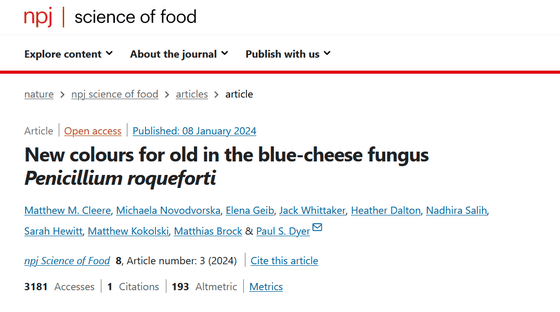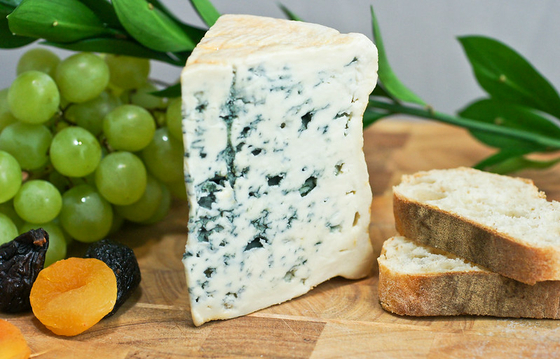Technology to make brown and pink blue cheese is developed.

Blue cheese is a cheese made from blue mold, and as the name suggests, 'blue-green streaks' are formed inside the cheese during the growth process of blue mold. A research team at the University of Nottingham in the UK has announced a study to create pink or yellow blue cheese by changing the color of this blue mold.
New colors for old in the blue-cheese fungus Penicillium roqueforti | npj Science of Food
https://www.nature.com/articles/s41538-023-00244-9

News - Scientists 'break the mold' by creating new colors of 'blue cheese' - University of Nottingham
https://www.nottingham.ac.uk/news/new-colours-of-blue-cheese
Blue cheese could get an upgrade thanks to new mold hybrids | New Scientist
https://www.newscientist.com/article/2420477-blue-cheese-could-get-an-upgrade-thanks-to-new-mould-hybrids/
Blue cheese is a cheese made using a blue mold called 'Penicillium roqueforti', and ' Roquefort ', which is called France's oldest cheese, is especially famous.
Penicillium roqueforti, which grows during the cheese ripening process, produces enzymes that break down proteins and fats, creating a unique flavor. In addition, Penicillium roqueforti softens the cheese and creates a creamy texture, while Penicillium roqueforti promotes secondary fermentation, which further advances the ripening of the cheese. As Penicillium roqueforti multiplies, blue-green streaks are formed inside the cheese, creating the appearance that gives it the name 'blue cheese.'

by
In 2014, research on Penicillium roqueforti progressed after the genome information of Penicillium roqueforti was made public. A research team from the University of Nottingham aimed to understand the genetic basis of pigment formation by modifying the genes that form the pigments in the spore coating of Penicillium roqueforti.
As a result, it was found that the pigment of Penicillium roqueforti gradually formed, and was initially white, then changed to yellow-green, reddish-brown, pink, dark brown, light blue, and finally became dark blue-green. Therefore, by deleting the gene that forms this pigment, we were able to change the color of Penicillium roqueforti spores without adversely affecting the production of volatile substances and secondary metabolites that give blue cheese its flavor. Succeeded.

However, food industry regulations prohibit commercial use of gene deletion strains. Therefore, the research team created a non-genetically modified strain through UV mutagenesis.
UV mutagenesis is a method that uses ultraviolet light (UV) to induce mutations in the genes of an organism, rather than directly manipulating the genes of the organism. By exposing Penicillium roqueforti to ultraviolet light, the DNA is damaged, and in the process of repairing the damage, mutations occur in the DNA base sequence, and individuals with changed colors are selected from the mutated strains. By utilizing this UV mutagenesis, the research team created a strain in which the pigment-forming gene was deleted, and succeeded in producing blue cheese that was not blue-green.

When we actually tried blue cheese made with the mutant strain, we found that the flavor strength and taste characteristics were different. As a result of the investigation, the mutant strain was able to produce volatile substances without any problems, and there were no major differences in the ingredients contained in the cheese, so the research team concluded, ``The taste may have changed due to the mutation of Penicillium roqueforti.'' 'The taste may have changed depending on the appearance.'
Paul Dyer, a member of the research team, said: ``People who tried the lighter-colored cheese found it to have a milder taste, whereas many people thought the darker-colored cheese had a richer taste.'' Also, people who tried reddish-brown or light green cheeses said they tasted fruity and tangy. It shows what you feel.”

The research team is collaborating with a local cheese maker and aiming to commercialize blue cheese using this mutant strain.
◆Forum now open
A forum related to this article has been set up on the GIGAZINE official Discord server . Anyone can write freely, so please feel free to comment! If you do not have a Discord account, please create one by referring to the article explaining how to create an account!
• Discord | 'Tell me your favorite cheese! Any cheese product is OK' | GIGAZINE
https://discord.com/channels/1037961069903216680/1217766095369539644
Related Posts:







